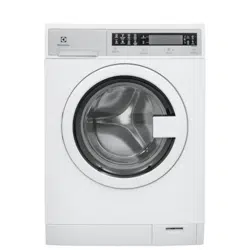Documents: Go to download!
- Owner's manual - (English)
- Features
- Operating Instructions
- Stain Removal Guide
- Care and Cleaning
- Solutions to Common Problems
Table of contents
USE & CARE GUIDE FRONT LOAD WASHER
Features
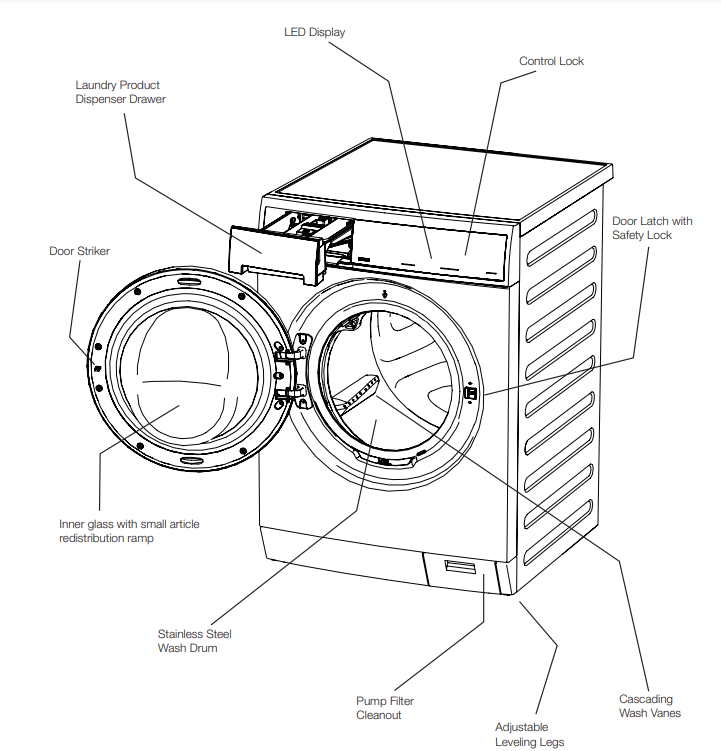
Operating Instructions
Normal Operating Sounds
A. DRAIN HOSE
The washer has a flexible drain hose to carry water from the washer to the stand pipe of your home. You will hear water flowing into your stand pipe. This is a normal part of the operation of the washer.
B. WATER VALVES/DISPENSER
As water enters the dispenser system, it is common to hear a water flowing sound. This normal sound will vary slightly based on the water pressure in your home.
C. DOOR LOCK
Your washer is equipped with a door lock with an electric solenoid. There will be a clicking sound as the washer door is being locked or unlocked.
D. DRAIN PUMP
Your washer is equipped with a high velocity drain pump. It is normal to hear humming and gurgling sounds as water is pumped from the washer. Both of these sounds are normal and indicate that your pump is functioning correctly.
E. HIGH SPEED MOTOR
A powerful motor is used to drive the drum to high spin speeds to extract water from your load. You will hear a sound associated with these higher spin speeds. This sound is normal and will vary slightly as the spin speed varies with load size and cycle selected
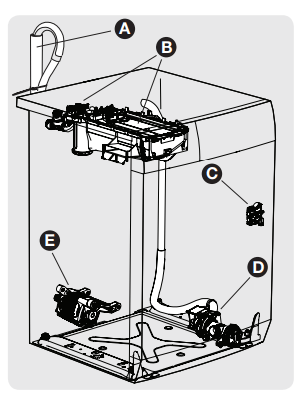
Operating Your Washer
1. Sort laundry into loads that can be washed together.
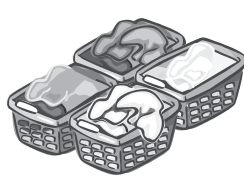
• Sort items by recommended cycle and water temperature.
• Separate white, light and colorfast items from dark and non-colorfast items.
• Separate items that shed lint from items that attract lint. Casual, synthetic, knit, and corduroy items will pick up lint from towels, rugs, and chenille bedspreads.
• Separate heavily soiled items from lightly soiled items.
• Separate lacy, sheer, loosely knit, or delicate items from durable items.
• Do not machine wash items containing fiberglass. Small particles of fiberglass left in the drum may transfer to fabrics in other loads and cause skin irritation.
2. Prepare items for washing.
• Empty pockets.

• Brush off lint and dirt. Shake out rugs and beach towels.
• Close zippers, fasten hooks, tie strings and sashes, and remove non-washable trims and ornaments.
• Mend rips and tears to prevent further damage during washing.
• Turn knit items inside out to prevent pilling.
• Place delicate and small items such as bras, hosiery and baby socks in a mesh bag.
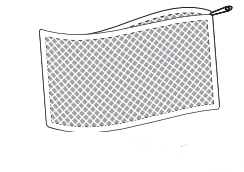
3. Pretreat stains and heavy soil.
• See Stain Removal Guide in this guide for safe, successful stain removal instructions.
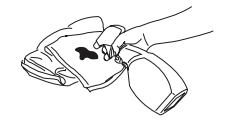
4. Add laundry load to washer.
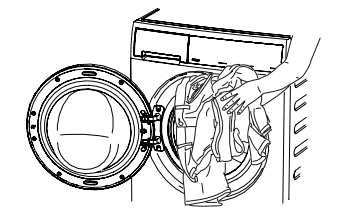
• Combine large and small items in a load.
• Load large items first. Large items should not be more than half the total wash load.
Make sure that no items stay between the seal and the door. There is a risk of water leakage or damage to the load.

• Washing single items such as a sweater, towel or jeans is inefficient and may cause an out-of-balance load. Add 1 or 2 similar items to help balance the load.
• The washer can be fully loaded, but the items should not be tightly packed. The door should close easily
5. Add laundry products to the dispenser.
- Detergent, liquid chlorine bleach and liquid fabric softener will be dispensed at the proper times in the cycle.
- Open and close the dispenser drawer slowly. Closing the drawer too quickly could result in early dispensing of the bleach or fabric softener.
Mainwash 
- Use the cap or scoop provided by the detergent manufacturer to measure the amount recommended. Detergent dosage may need to be adjusted for water temperature, water hardness, load size and soil level.
- Do not mix liquids and powders.
Mainwash - Liquid Detergent 
- Ensure the flap in the downward position.
- Add the recommended amount of liquid detergent to the “Main Wash” compartment.
- To prevent staining, do not overfill the fabric softener chamber or pour liquid fabric softener directly on the wash load.
Mainwash - Powder Detergent 
- Ensure the flap in the upward position.
- Add the recommended amount of high-efficiency powder detergent to the “Main Wash” detergent chamber.

Other Wash Products
Color-safe bleach, water conditioner, detergent booster and enzyme products may be added with the detergent. Put liquid products with liquid detergent in the mainwash (liquid) chamber or powder products with powder detergent in the mainwash (powder) chamber
- Do not mix liquids and powders
- Use of multi-product (detergent plus softener) sheets or color-absorbing sheets NOT recommended. They could disable your machine and result in unwarranted repair costs.
Prewash 
- For heavily soiled or stained loads, select the prewash option and add the recommended amount of detergent to the “Pre-Wash” detergent compartment
Liquid Chlorine Bleach
- If desired, add liquid chlorine bleach to the chamber.
- DO NOT fill above the maximum fill line.
- Add color-safe bleach with the detergent.
- To prevent fabric damage, do not overfill the “Liquid Bleach” chamber or pour liquid chlorine bleach directly onto the load.
Liquid Fabric Softener 
- If desired, pour the recommended amount of liquid fabric softener into the chamber marked with this symbol.
- Fill to the MAX line for large loads.
- DO NOT fill above the maximum fill line.
- Use of a fabric softener-dispensing ball is not recommended in tumble action washers.
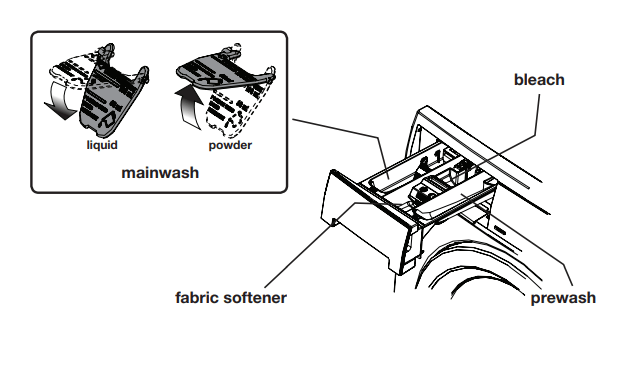
6. Select the appropriate cycle and settings for the load.
- Press the Power button to turn on the unit.
- Select a desired cycle by pressing its icon.
- The estimated cycle time, rinse water temperatures, final spin speed, and soil level for each cycle will be indicated for the cycle selected. See the “Washer Settings Chart” for more details.
- To change the settings, press the temperature, spin speed and soil level icons to scroll to the desired settings.
- To select or delete an option, press the icon for that option. The indicator will be illuminated when the option has been selected. The indicator will no longer be lighted when the option has been deleted.
- To provide the best care for your laundry, not every setting or option is available with every cycle. If a setting or option is not available for the cycle selected, the indicator will not light.
7. Start the washer.
- Close the door and press Start. The washer will not operate with the door open. “Check the door” will be displayed as a reminder to close the door.
- Select delay start to delay the beginning of the cycle, if desired.
- As a safety measure, the door will automatically lock during the entire wash cycle and the door lock indicator will be lighted.
- To add a forgotten item to the wash drum, press Pause and open the door. “Pause” will be displayed along with the estimated remaining cycle time. Add the item, close the door and press Start to resume the cycle.
- If changes to the settings or options are attempted after the cycle starts, you will hear several beeps when the buttons are pressed. To change the settings or options, press Pause, make the new selections and press Start again.
- To change the cycle once the cycle has begun, press the Power button to cancel the current cycle, press the Power button to turn on unit again, select a new cycle, and press Start again. Just pressing another cycle icon will not change the cycle.
- To stop the cycle, press the Power button.
- A signal will sound at the end of the cycle if the chime option has been selected.
- Remove items from the washer when the cycle ends and place in dryer, line dry or dry flat as directed on the fabric care label.
- Excess wrinkling, color transfer or odors may develop in items left in the washer after the cycle has ended, if not removed promptly.
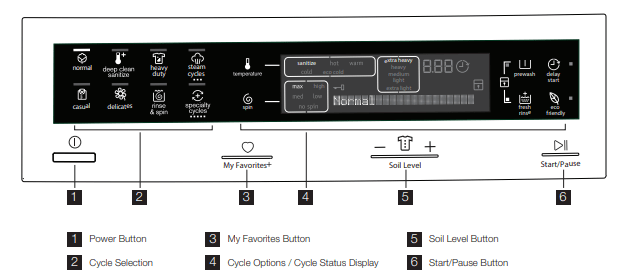
Cycle Selection
Press the Power button to turn on the unit. Press the icon for the cycle desired and the indicator for that cycle will be illuminated.
To change the cycle once the cycle has begun, press the Power button to cancel the current cycle, press the Power button to turn on unit again, select a new cycle, and press Start again. Just pressing another cycle icon will not change the cycle.
normal
- Use this load for cotton, linen, towels, shirts, sheets, denims and mixed loads.
deep clean sanitize
- Use the deep clean sanitize cycle to clean and sanitize heavily soiled, colorfast fabrics including towels, bedding, and children’s clothing.
- It is recommended that you set your water heater to 120° F (49° C) or higher to ensure proper performance during this cycle. If the setting is lower or the load is extra large, the cycle time will be extended by 30 minutes or more.
- The sanitize cycle will kill 99.9% of bacteria with no carryover of bacteria between loads. No bleach or harsh chemicals are needed, but higher temperatures are required. Please check fabric care labels to prevent damage. Only sanitizing cycles have been designed to meet the requirements of NSF P172 protocol for sanitization efficacy.
- The wash water is heated by an internal boost heater as the load tumbles. Cold water is added to cool down the load prior to drain and spin.
- If the voltage at your outlet is under 110 v, the internal heater may not adequately heat the wash water. If the cycle is interrupted while the water is heating, the final temperature of the wash water may be lower and sanitization may be reduced.
heavy duty
- Use this cycle for heavily soiled, durable garments - ex. towels, sports gear, or fabric tote bags. For best soil and stain removal, use the hottest water safe for the fabrics being washed.
casual
- Use this cycle for cottons and blends with a permanent press or no-iron finish.
delicates
- Use this cycle for lightly soiled knits and delicates which require gentle washing.
rinse & spin
- Select rinse & spin for loads that need a cold water rinse or to add fabric softener that may have been omitted in a regular cycle. Add the fabric softener to the dispenser chamber. Select the spin speed appropriate for the load.
- You may deselect fresh rinse if you wish to perform a spin only cycle or select no spin if you want to perform a drain only cycle.
Steam Cycle Selection
To scroll through the steam cycles, continue to press the steam cycles icon. The selected cycle will be displayed on the text display
- Steam may not necessarily be visible inside drum during the steam cycles.
- Steam may not be present during entire cycle.
- If washer is paused during the steam portion of a steam cycle, the door will remain locked due to higher temperature in drum. DO NOT force open - it will unlock upon cooling.
steam refresh
Refresh a small load of dry clothes with the perfect amount of steam. Steam alone will infuse into the dry load as it tumbles to refresh fabrics, remove odors, and release wrinkles, reducing ironing. Remove load, hang or iron as necessary.
normal with steam
- STEAM REFRESH is not a washing cycle. It is intended for clean, dry clothes. Take care not to load items with stains.
- Steam cycle for cotton, linen, towels, shirts, sheets, denims and mixed loads.
casual with steam
Steam cycle for cycle for cottons and blends with a permanent press or no-iron finish.
Specialty Cycle Selection
To scroll through the specialty cycles, continue to press the specialty cycles icon. The selected cycle will be shown on the text display.
fast wash
Quickly wash a small, lightly soiled load in 22 minutes.
whites
Use this cycle for white fabrics and lightly colored clothing. Refer to fabric care label for use of liquid chlorine bleach. Hot water is recommended to ensure optimal bleach activation. For peak rinsing performance and to avoid chlorine residues on your laundry add fresh rinse to this cycle.
wool
- Designed for a small load of machine-washable woolen items, the wool cycle uses gentle washing action along with cold rinses to eliminate shrinking and damage to wool. You may steam refresh use an wool detergent approved for front load washers.
- Washing wool garments labeled “Dry Clean Only” or using chlorine bleach can result in permanent damage.
jeans
Select this specialty cycle for washing an entire load of lightly to normally soiled denim jeans or similarly-colored cotton khakis.
clean washer
To clean and freshen the washer, perform the clean washer cycle. This maintenance cycle uses hot water and two cold rinses to remove residue that may cause odor. See “Inside Routine Cleaning (Preventive)” for detailed information about the clean washer cycle.
Cycle Settings
Appropriate wash temperature, spin speeds, soil level and options will be displayed for each cycle. The settings can be changed before the cycle is started. Make modifications according to fiber content, colorfastness and soil level. If changes are attempted after the cycle starts a signal will beep and “Not possible” will be displayed.
To change settings after the cycle starts, press Pause, adjust the setting and press Start to resume the cycle.
Wash Water Temperature
To change the preset temperature, press the temperature icon to scroll to the desired setting. A cold water rinse saves energy and reduces wrinkling.
To protect your fabrics, not all temperatures are available with every cycle. The indicator will not light if the setting is not available with that cycle.
Wash water temperatures are automatically regulated to maximize detergent effectiveness and improve washing performance. The water heater setting and its distance from the washer, water usage in other parts of the home, and seasonally low ground water temperature in some geographic areas can affect water temperature.
sanitize
This setting sanitizes heavily soiled colorfast fabrics such as towels, bedding, and children’s clothing by killing 99.9% of bacteria using wash water heated with a boost heater. Cold water is used to cool and rinse the load.
hot
Use this setting for heavily soiled white or colorfast cottons and blends. warm Use this setting for normally soiled white or colorfast cottons or blends.
cold
Some warm water will automatically blend with cold tap supply to achieve a precise cold. Use this setting for lightly soiled non-colorfast items, knits, delicates, and hand washables.
eco cold
Wash and rinse temperatures are equivalent to temperature of cold tap supply. Use this selection for fabrics and colors that are prone to dye transfer. For use with cold water detergents.
Spin Speed
Level Max, high, medium and low spin speeds are available for each cycle. The spin speed and/or duration of final spin vary from model to model and cycle to cycle. Increasing the spin speed will extract more water, decrease drying time and conserve energy. Decreasing the spin speed will reduce wrinkling.
Select low spin speed to gently spin items that should be line dried.
Use no spin to omit all intermediate spinning phases and the final spin at the end of the cycle. The load will be very wet. Remove items from the wash drum to drip dry or select a rinse & spin cycle to remove excess water at a more convenient time.
Spoil level
Adjust the wash time based on the soil level of each load. Extra heavy, heavy, medium, light, and extra light soil levels are available.
Cycle Options
To add options, press the corresponding option’s icon to illuminate the selection desired. To delete options, press the option’s icon again and the indicator light will turn off. Not all options are available on every model. To protect your fabrics, not all options are available with every cycle. If an option is not appropriate for the cycle, the indicator will not light. Occasionally, a setting and option in the same cycle will conflict with each other, like no spin (or low spin) and eco friendly. When this happens, the eco friendly option will override any incompatible selections.
prewash
Select this option to add a short initial wash period to a cycle. Heavily soiled and stained loads will prewash for approximately 15-20 minutes. The water will drain and the load will automatically advance to the regular wash cycle.
fresh rinse
Use this option when additional rinsing is desired to remove excess dirt and detergent. It is recommended for heavily soiled loads or if household members have sensitive skin.
eco friendly
The eco friendly option reduces the amount of hot water usage and total cycle duration to to save energy. See Washer Settings Chart for compatible cycles.
Other Features

My Favorites
After some time of initial usage, the washer will automatically remember the 3 most used cycles with their settings and options. To cycle through this list continue to press the My Favorites button. Press Start after your desired cycle appears.
Door Lock Indicator 
While the cycle is in progress the door lock indicator will be lit. When the indicator is lit, do not force open the door. Wait until the indicator is off.
Chime
A chime will sound at the end of the cycle when this option is selected. The signal can be turned on or off by pressing the fresh rinse and eco friendly icons at the same time.
Delay Start
Press delay start to select a wash time convenient to your schedule or during off peak energy hours. The delay time selected will be displayed and begin counting down when you select Start.
Control Lock 
To avoid having someone accidentally start or stop the washer, press prewash and fresh rinse at the same time and hold until the  indicator is lit. To unlock the controls, press prewash and fresh rinse at the same time and hold until the
indicator is lit. To unlock the controls, press prewash and fresh rinse at the same time and hold until the indicator is no longer lit.
indicator is no longer lit.
Status Display/Timer
The estimated total cycle time will be displayed when the cycle is selected. The time may increase if water pressure is low, oversudsing occurs or the load becomes unbalanced. The estimated remaining cycle time is displayed during the cycle.
Fresh Rinse Default
To programme your unit to perform a default fresh rinse at the end of every compatible cycle, press prewash and delay start icons simultaneously. Press fresh rinse to turn it off for any given cycle while in default fresh rinse mode. To turn default fresh rinse mode off, press prewash and delay start again til fresh rinse light turns off.
Pump Cleanout/Manual Drain
In the event the washer will not drain under its own power due to a power outage or clogged drain pump you can drain the water left in the tub manually.
Washer Settings Chart

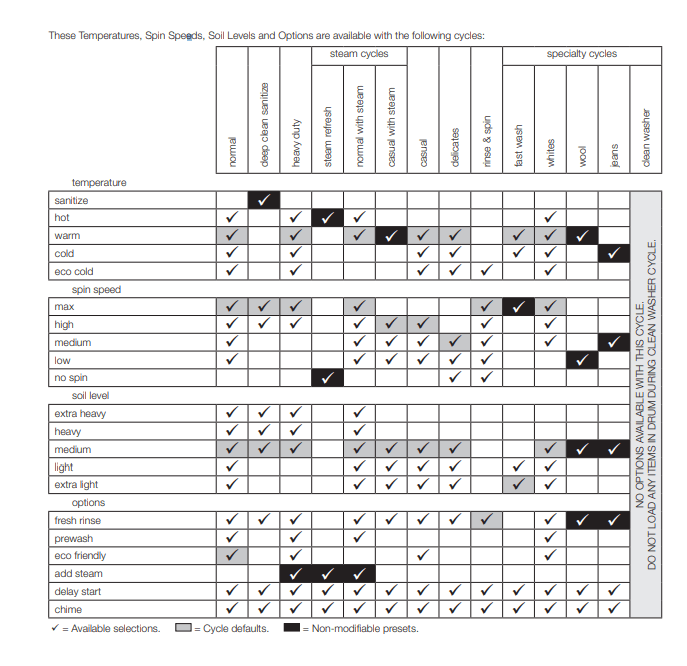
Stain Removal Guide
Safe Stain Removal Procedures
To reduce the risk of fire or serious injury to persons or property, comply with the basic warnings listed below:
- Read and comply with all instructions on stain removal products.
- Keep stain removal products in their original labeled containers and out of children’s reach.
- Thoroughly wash any utensils used.
- Do not combine stain removal products, especially ammonia and chlorine bleach. Dangerous fumes can result.
- Never wash items which have been previously cleaned in, washed in, soaked in or spotted with gasoline, dry cleaning solvents or other flammable or explosive substances because they give off vapors that could ignite or explode.
- Never use highly flammable solvents, such as gasoline, inside the home. Vapors can explode on contact with flames or sparks.
For Successful Stain Removal:
- Remove stains promptly.
- Determine the kind of stain, then follow the recommended treatment in the stain removal chart on the next page.
- To pretreat stains, use a prewash product, liquid detergent, or a paste made from powder detergent and water.
- Use cold water on unknown stains as hot water can set stains.
- Consult care label instructions for treatments to avoid on specific fabrics.
- Check for colorfastness by testing stain remover products on an inside seam.
- Rinse and wash items after stain removal.
Stain Removal Suggestions
Adhesive tape, chewing gum, rubber cement
- Apply ice. Scrape off excess. Place stain face down on paper towels. Saturate with prewash stain remover or nonflammable dry cleaning fluid.
Baby formula, dairy products, egg
- Use product containing enzymes to pretreat or soak stains. Soak for 30 minutes or more. Wash.
Beverages (coffee, tea, soda, juice, alcoholic beverages)
- Pretreat stain. Wash using cold water and bleach safe for fabric.
Blood
- Rinse with cold water. Rub with bar soap. Or, pretreat or soak with product containing enzymes. Wash using bleach safe for fabric.
Candle wax, crayon
- Scrape off surface wax. Place stain face down between paper towels. Press with warm iron until wax is absorbed. Replace paper towels frequently. Treat remaining stain with prewash stain remover or nonflammable dry cleaning fluid. Hand wash to remove solvent. Wash using bleach safe for fabric.
Chocolate
- Pretreat or soak in warm water using product containing enzymes. Wash using bleach safe for fabric.
Collar or cuff soil, cosmetics
- Pretreat with prewash stain remover or rub with bar soap. Dye transfer on white fabric Use packaged color remover. Wash using bleach safe for fabric.
Grass
- Pretreat or soak in warm water using product containing enzymes. Wash using bleach safe for fabric.
Grease, oil, tar (butter, fats, salad dressing, cooking oils, car grease, motor oils)
- Scrape residue from fabric. Pretreat. Wash using hottest water safe for fabric. For heavy stains and tar, apply nonflammable dry cleaning fluid to back of stain. Replace towels under stain frequently. Rinse thoroughly. Wash using hottest water safe for fabric.
Ink
- Some inks may be impossible to remove. Washing may set some inks. Use prewash stain remover, denatured alcohol or nonflammable dry cleaning fluid.
Mildew, scorch
- Wash with chlorine bleach if safe for fabric. Or, soak in oxygen bleach and hot water before washing. Badly mildewed fabrics may be permanently damaged.
Mud
- Brush off dry mud. Pretreat or soak with product containing enzymes.
Mustard, tomato
- Pretreat with prewash stain remover. Wash using bleach safe for fabric.
Nail polish
- May be impossible to remove. Place stain face down on paper towels. Apply nail polish remover to back of stain. Repeat, replacing paper towels frequently. Do not use on acetate fabrics.
Paint, varnish
- WATER BASED: Rinse fabric in cool water while stain is wet. Wash. Once paint is dry, it cannot be removed. OIL BASED AND VARNISH: Use solvent recommended on can label. Rinse thoroughly before washing.
Perspiration
- Use prewash stain remover or rub with bar soap. Rinse. Wash using nonchlorine bleach in hottest water safe for fabric.
Rust, brown or yellow discoloration
- Use rust remover safe for fabric. Do not use chlorine bleach because it may intensify discoloration.
Shoe polish
- LIQUID: Pretreat with a paste of powder detergent and water. PASTE: Scrape residue from fabric. Pretreat with prewash stain remover or nonflammable dry cleaning fluid. Rinse. Rub detergent into dampened area. Wash using bleach safe for fabric.
Tomato
- Pretreat with prewash stain remover. Wash using bleach safe for fabric.
Urine, vomit, mucus, feces
- Pretreat or soak in product containing enzymes. Wash using bleach safe for fabric.
Wine
- Pretreat or soak in cold water. Wash in hottest water and bleach safe for fabric
Care and Cleaning
Inside Routine Cleaning (Preventive)
To help prevent odors, mold or mildew, leave the door open for a few hours after use or whenever the washer is not in use.
To refresh or clean inside of water
- To clean and freshen the washer, perform the clean washer cycle. For best results use the clean washer cycle once a month.
- Press the Power button to wake up the unit. Select the clean washer cycle by continuing to press the specialty cycle icon until clean washer is displayed.
- Place the mainwash detergent chamber in the upward position. REMOVE ALL ITEMS FROM WASH DRUM before filling the detergent chamber with one (1) cup of liquid chlorine bleach OR one (1) pouch of TIDE® WASHING MACHINE CLEANER. DO NOT use both. Press Start to begin.
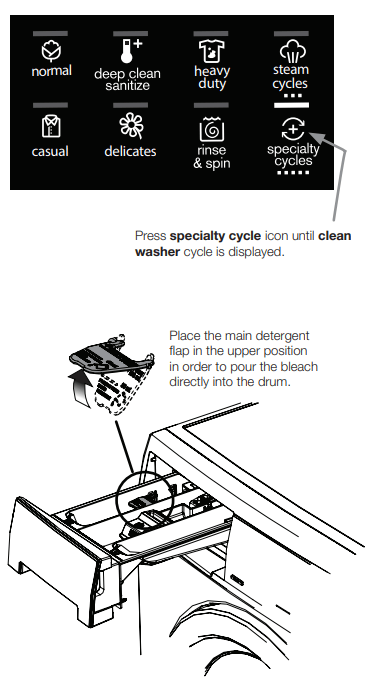
Performing Manual Drain
In the event the washer will not drain under its own power due to a power outage or clogged drain pump you can drain the water left in the drum manually.
In the event the washer will not drain under its own power due to a power outage or clogged drain pump you can drain the water left in the drum manually.
- Remove pump cleanout door.
- Place a catch pan underneath the drain pump filter to collect water as it drains.
- Without removing the pump filter, rotate the filter 180° counterclockwise to allow the water to flow out into the catch pan. It may be necessary to close the filter and drain the catch pan as it fills.
- Repeat the process until all the water has been drained.
Cleaning Pump Filter
With the wash tub and drain hose drained of all water and the drain spout snapped in place, follow these directions to remove, clean, and reinsert the pump filter.
- “Unscrew” the filter and pull it out.
- Dump the filter and inspect the opening for any loose objects.
- Rinse the filter completely before putting it back in place.
- “Screw” filter back in place until it stops. DO NOT overtighten.
- Reinstall pump cleanout door if removed earlier
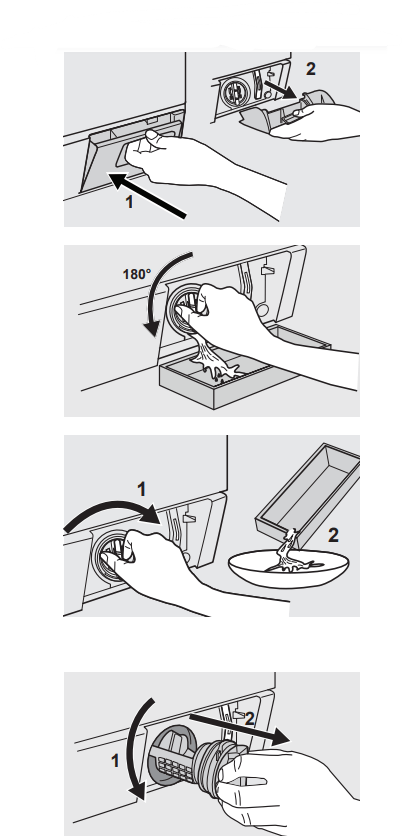
Other Inside Routine Cleaning (Preventive)
Cleaning Dispenser Drawer Area
- Remove the drawer by pulling the drawer out until it stops.
- Reach back into the back of the drawer cavity and press down firmly on the lock tab. Pull out the drawer.
- Remove the inserts from the bleach and fabric softener compartments.
- Rinse the drawer and inserts with a combination of ¾ cup liquid chlorine bleach and 1 gallon hot tap water to remove traces of accumulated powders and liquids. Large amounts of fabric softener residue may indicate improper dilution or more frequent cleaning is required. Rinse well with tap water.
- To clean the drawer opening, use a small brush to clean the recess. Remove all residue from the upper and lower parts of the recess.
- Replace the inserts by pressing in place until you hear a slight click. Return the dispenser drawer.

Daily Preventive Maintenance
- Remove items from the washer as soon as the cycle ends. Excess wrinkling, color transfer, and odors may develop in items left in the washer.
- If there are no small children or pets present, you may leave the door ajar when the washer is not in use.
- Leave the dispenser drawer open slightly at the end of the wash day.
- Dry around the washer door opening, flexible gasket, and door glass. These areas should always be clean to ensure a water tight seal.
- When extremely soiled items have been washed, a dirty residue may remain on the drum. Remove this by wiping the drum with a nonabrasive household cleanser. Rinse thoroughly with water.
- Periodically, wipe dry the folds in the bottom of the flexible gasket to remove lint and other debris.
Inside Cleaning (Aggressive)
In cases where the clean washer cycle along with care and cleaning of rubber gasket folds isn’t done, and severe odor, mold, mildew, or residue buildup have developed, follow the below cleaning procedure to help alleviate the problem.
CLEANING PROCEDURE - Washer Drum
Ensure the wash tub is empty (or no clothes load). Open the detergent drawer and pour eight (8) cups of bleach into the detergent compartment. Select clean washer cycle as described previously in Inside Routine Cleaning (Preventive).
Upon cycle completion inspect the interior of the washer to see if the odor/residue has been eliminated. If any additional cleaning is required, repeat the above procedure. This may take several cycles depending on the severity of the odor/residue. You may observe some remaining discoloration due to the long term effects of this residue.
For especially contaminated areas visible inside the drum (including the front rubber seal), these areas might be more effectively cleaned by spraying a Bleach Cleaner on a scrub brush, soft sponge, or towel and scrubbing. If odor is still left after bleach cycle(s) and bleach cleaner, open the detergent drawer and pour one (1) pouch of TIDE® WASHING MACHINE CLEANER in detergent drawer. Select clean washer cycle and start the washer.

Outside Routine Cleaning
- When washing is completed, wipe top and sides of washer with a damp cloth. Turn water faucets off to prevent pressure build-up in the hoses.
- Clean the cabinet with mild soap and water. Never use harsh, gritty or abrasive cleansers
- If the cabinet becomes stained, clean with diluted chlorine bleach (1 part bleach to 8 parts water). Rinse several times with clear water.
- Remove glue residue from tape or labels with a mixture of warm water and mild detergent. Or, touch residue with the sticky side of tape.
- When cleaning chrome parts use a window cleaner with ammonia or mild soap and water.
- Before moving the washer, place a strip of cardboard or thin fiberboard under the front leveling legs to prevent damage to the floor.
Winterizing Instructions
- Turn off water supply faucets.
- Disconnect hoses from water supply and drain water from hoses.
- Plug electrical cord into a properly grounded electrical outlet.
- Perform manual drain to remove all water from the washer. Follow manual draining instructions in the Care and Cleaning section.
- Remove dispenser drawer. Drain any water in compartments and dry compartments. Replace drawer.
- Store washer in an upright position.
Solutions to Common Problems
Common Washing Problems
PROBLEM | POSSIBE CAUSES | SOLUTIUNS | PREVENTIVE MEASURES |
Blue stains |
|
|
|
Discoloration, graying |
|
|
|
Greasy, oily stains |
|
|
|
Holes, tears, or snags |
|
|
|
Lint |
|
|
|
Pilling (Fibers ball up and cling to fabric.) |
|
|
|
Residue or powder on dark items; Stiff, harsh fabrics. |
|
|
|
Wrinkling |
|
|
|
Yellow buildup of body soil on synthetic fabrics |
|
|
|
Yellow or brown rust stains |
|
|
|
Residue stains / buildup, mold or mildew stains in gasket |
|
|
|
Residue stains / buildup, mold or mildew stains in dispenser drawer |
|
|
|
Water in fold of flexible gasket |
|
|
|
Odor |
|
|
|
Service Prevention Checklist
OCCURRENCE | POSSIBLE CAUSE | SOLUTION |
NOISE | ||
High pitch "jet engine" noise. | A certain amount of motor whine is normal during the spin cycle. |
|
Rattling and clanking noise. | Foreign objects such as coins or safety pins may be in drum or pump. | Stop washer and check drum. If noise continues after washer is restarted, objects may be in pump. Call your authorized semicer. |
Belt buckles and metal fasteners are hitting wash drum. | To prevent unnecessary noise and damage to drum, fasten fasteners and turn items inside out. | |
Thumping sound. | Heavy wash loads may produce a thumping sound. This is usually normal. If sound continues, washer is probably out of balance. | Stop washer and redistribute wash load. |
Vibrating noise. | Washer is not resting firmly on floor. | Move washer so it rests firmly on floor. Adjust leveling legs. See INSTALLATION INSTRUCTIONS for details. |
Shipping bolts and foam block have not been removed during installation. | See INSTALLATION INSTRUCTIONS for removing shipping bolts and foam block. | |
Wash load unevenly distributed in drum. | Stop washer and rearrange wash load. | |
OPERATING | ||
Washer does not start. | Electrical power cord may not be plugged in or connection may be loose. | Make sure plug fits tightly in wall outlet. |
House fuse blown, circuit breaker tripped, or a power outage has occurred. | Reset circuit breaker or replace fuse. Do not increase fuse capacity. If problem is a circuit overload, have it corrected by a qualified electrician. If problem is a power outage, call local electric company. | |
Water supply faucets are not turned on. | Turn on water supply faucets. | |
Motor is overheated. Washer motor will stop if it becomes overheated. | It will automatically restart after a cool down period of up to 30 minutes (if washer has not been manually turned off). | |
Washer door is not completely closed. | Close door completely. | |
Washer won't spin. | Load is too small. | Add 1 or 2 similar items to help balance the load. |
Residue left in drum. | Heavily soiled items. | Wipe drum with a nonabrasive household cleanser, then rinse. Shake or brush excess dirt and sand from items before washing |
SHOWN IN LED DISPLAY | ||
"Check the tap" | Water inlet hoses are not installed. | Install Hot and Cold water hoses and turn on Hot and Cold water supply valves. |
No or slow water fill | Water supply valves are not turned on. | Turn on Hot and Cold water supply valves. |
Water supply is not adequate in installation. | Test water pressure at another faucet in the house. Water pressure must be at least 30 psi (260 kPa). | |
Water is being used elsewhere in the house. | Avoid running water elsewhere while washer is filling. | |
Water inlet hoses are kinked. | Straighten hoses. | |
Water inlet screens are clogged. | Remove hoses and clean sediment from screens. | |
"Check drain filter" | Drain pipe blocked. | Unclog drain pipe. |
Washer experiencing drain problems during cycle | Pump filter clogged. | See Care and Cleaning for pump filter cleaning instructions. |
"Check the door" |
| Close door completely. |
Washer door is open or not closed completely |
|
|
"Water safety alert" Washer not maintaining | Drain pipe position too low and water siphoning out drain hose. | Drain pipe height must be minimum 24" above bottom of unit. Refer to Installation Instructions for correct drain pipe installation requirements and adjust accordingly |
water level | If drain pipe height is adequate, error detected can only be resolved by calling semice technician. | Close all water supply faucets and call your authorized servicer. |
"Detergent overdosing" Too many suds detected | An excessive amount of detergent has been added, causing extra suds; additional rinsing has not corrected the issue. | Use less detergent. Verify detergent is fit for use in front load washers. Look for this symbol on the detergent label: |
WATER | ||
Water collects in folds of the bellows at the end of the cycle. | This is a result of the washing action and is part of the normal operation of the washer. |
|
Water collects in bleach and fabric softener compartments. | This is a result of the siphoning action and is part of the normal operation of the washer. | Water may be removed by removing the dispenser drawer (see Care and Cleaning in this guide) and draining water into the empty drum or sink. |
Wash load too wet after spin. | Washer is overloaded. | Do not overload washer. See Operating Your Washer. |
Load is too small. | Add 1 or 2 similar items to help balance the load. | |
Load is out of balance. | Rearrange load to allow proper spinning. | |
Drain hose is kinked. | Straighten drain hose. | |
Water does not enter washer or it enters slowly . | Water supply is not adequate in area. | Check another faucet in the house. Wait until water supply and pressure increase. |
Water supply faucets are not completely open. | Fully open hot and cold faucets. | |
Water is being used elsewhere in the house. Water pressure must be at least 10 psi (70 kPa). | Avoid running water elsewhere while washer is filling. | |
Water inlet hoses are kinked. | Straighten hoses. | |
Warm or hot water is not hot enough. | Hot water heater is set too low or is a distance from washer. | Measure hot water temperature at nearby faucet with candy or meat thermometer. Water temperature should be at least 120°F (49°C). Adjust water heater as necessary. |
Hot water is being used elsewhere in the house. | Avoid using hot water elsewhere before or during washer use. There may not be enough hot water available for proper cleaning. If problem persists, your hot water system may be unable to support more than 1 use at a time. | |
Water in washer does not drain or drains slowly. | Drain hose is kinked or clogged. | Clean and straighten the drain hose. |
Drain hose standpipe is too tall. Maximum standpipe height is 56.5” (144 cm). | Reduce standpipe height to less than 56.5” (144 cm). See INSTALLATION INSTRUCTIONS. | |
House drain pipes are clogged. | Unclog drain pipes. Contact plumber if necessary. | |
Water leaks. | Fill hose connection is loose at faucet or washer. | Check and tighten hose connections. Ensure rubber sealing washers are installed. |
Oversudsing. | Wrong detergent. | Run rinse cycle. Use a low-sudsing, high efficiency detergent. |
Too much detergent. | Run rinse cycle. Use less detergent in future loads. | |
Incorrect wash and rinse temperatures. | Hot and cold water hoses are connected to wrong supply faucets. | Connect hot water hose to hot water faucet and cold water hose to cold water faucet. |
Water is entering washer but tub does not fill. | Drain hose standpipe is too low. Standpipe must be a minimum of 24” (61 cm) high to prevent siphoning. | Increase standpipe height to at least 24” (61 cm). See INSTALLATION INSTRUCTIONS. |
See other models: EFLS617STT EFLS210TIS EFLW427UIW EFLS527UIW EFLS527UTT
 .
.